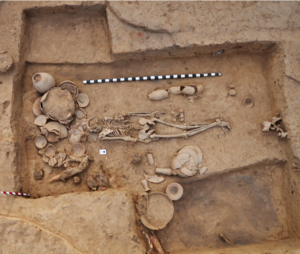Difference between revisions of "Indus Valley DNA"
BharataPuru (talk | contribs) (Created page with "File:Shinde et al 2019.png|thumb|390x390px|Indus Valley Civilisation (IVC) Cline is a mixture of Indian neolithic (India_N) ancestry as major component with a small componen...") |
(No difference)
|
Revision as of 10:55, 30 April 2022
In 2019, for the first time several ancient DNA samples related to the people of Indus-Saraswati Civilisation were published. Shinde et al 2019 published the only bronze age DNA samples found in India. This DNA sample was extracted from a skeleton found at archaeological site of Rakhigarhi located in the ancient Saraswati river plains. It was dated to ~2500 BC and the skeleton belonged to a woman. Narasimhan et al 2019 published hundreds of DNA samples along with thirteen samples belonging to Indus valley migrants found in the Turan region which includes modern day Iran and Turkmenistan regions. These DNA samples were dated variously between 3200 BC to 2000 BC and changed our understanding of the modern Indian population.
The Iranian related component that was once hypothesised to have arrived in India along with farming has turned out to be much more ancient. As the Shinde et al 2019 paper says, "Iranian-related ancestry in South Asia split from Iranian plateau lineages >12,000 years ago", implying that the people of Indus Valley and ancient Iranians had a common ancestor who lived more than 12,000 years ago. This ancestry is sometimes referred to as Indian neolithic ancestry (India_N). This discovery lead the scientists to make the conclusion that farming is indigenous to the Indian subcontinent and was not brought in from the western first farmers of Anatolia.
Narasimhan paper disproved the older assertion made by Damgard et al 2018 which claimed that BMAC is a source of ancestry to modern South Asians. Narasimhan paper published large number of bronze age DNA samples from BMAC region and found that BMAC is not the source of ancestry to the modern South Asians but in contrast BMAC main population has South Asian ancestry deeply rooted in time. Rather than showing migration into the Indian subcontinent, the bronze age DNA shows migration of people from South Asia to BMAC regions.
IVC cline
Indus Valley DNA is characterised by the combination of one DNA sample found at Rakhigarhi published by Shinde et al 2019 and 11 Indus periphery cline DNA samples extracted from the skeletons found at archaeological sites in Iran and Turkmenistan region where they are identified as outliers published in Narasimhan et al 2019. The excessive AHG related ancestry in those 11 samples had indicated that those samples could belong to the migrants from the IVC. These 12 samples together are referred as IVC cline samples.
The authors of Shinde et al says,
"While our study is sufficient to demonstrate that this ancestry profile was a common feature of the IVC, a single sample—or even the gradient of 12 likely IVC samples we have identified cannot fully characterise a cosmopolitan ancient civilisation. An important direction for future work will be to carry out ancient DNA analysis of additional individuals across the IVC range to obtain a quantitative understanding of how the ancestry of IVC people was distributed and to characterise other features of its population structure."
Rakhigarhi DNA
Rakhigarhi is a village in Hisar district in the state of Harayana in India. Rakhigarhi is now the largest site of the Indus-Saraswati Civilisation popularly known as Indus Valley Civilisation. For the first time the scientists were able to successfully extract DNA sample from bronze archaeological sites of Indus Valley Civilisation. The scientists attempted to generate genome-wide data from skeletal remains of 61 individuals from Rakhigarhi. But only a single sample yielded enough authentic ancient DNA for analysis, that sample is named I6113. The reason for this scarcity of ancient DNA samples available from Indian subcontinent is the tropical weather of India which has caused contamination to the ancient skeletons thus rendering the DNA samples useless for analysis. Despite of hundreds of excavated skeletons from the bronze age sites of IVC, so far the scientists have only been able to extract one low coverage samples from Rakhigarhi. The skeletal samples from Rakhigarhi were excavated by the archaeological team led by Dr. Vasant Shinde at the Deccan College Post-Graduate and Research Institute in Pune India and sampled by the ancient DNA group led by Dr. Niraj Rai at the Birbal Sahni Institute of Palaeosciences in Lucknow India.
DNA analysis
The analysis of the DNA has changed the understanding of the modern Indian population and also helped understanding the genetic make up of the people that created the metropolitan cities of the Indus-Saraswati Civilisation, the advancement of which are incomparable to rest of the contemporary world. The scientists identified Rakhigarhi skeleton with that of a female and determined that its mitochondrial haplogroup was U2b2, which is absent in whole mitochondrial genomes sequences available from about 400 ancient Central Asians; today, this specific haplogroup is nearly exclusive to South Asia. The major observation made by the scientists using the DNA analysis are
- The IVC ancestry is the major source of ancestry for the modern South Asian population.
- The IVC and ancient Iranians come from a common ancestry who lived more than 12,000 years ago.
- Farming is indigenous to the Indian subcontinent and developed by local foragers.
- The Iranian-related or the Indian neolithic ancestry is the major source of ancestry (~80%) for the IVC people.
- The IVC population has no ancestry from Central Asian populations.
- Anatolian or Iranians farmer do not contribute to the IVC genome.

